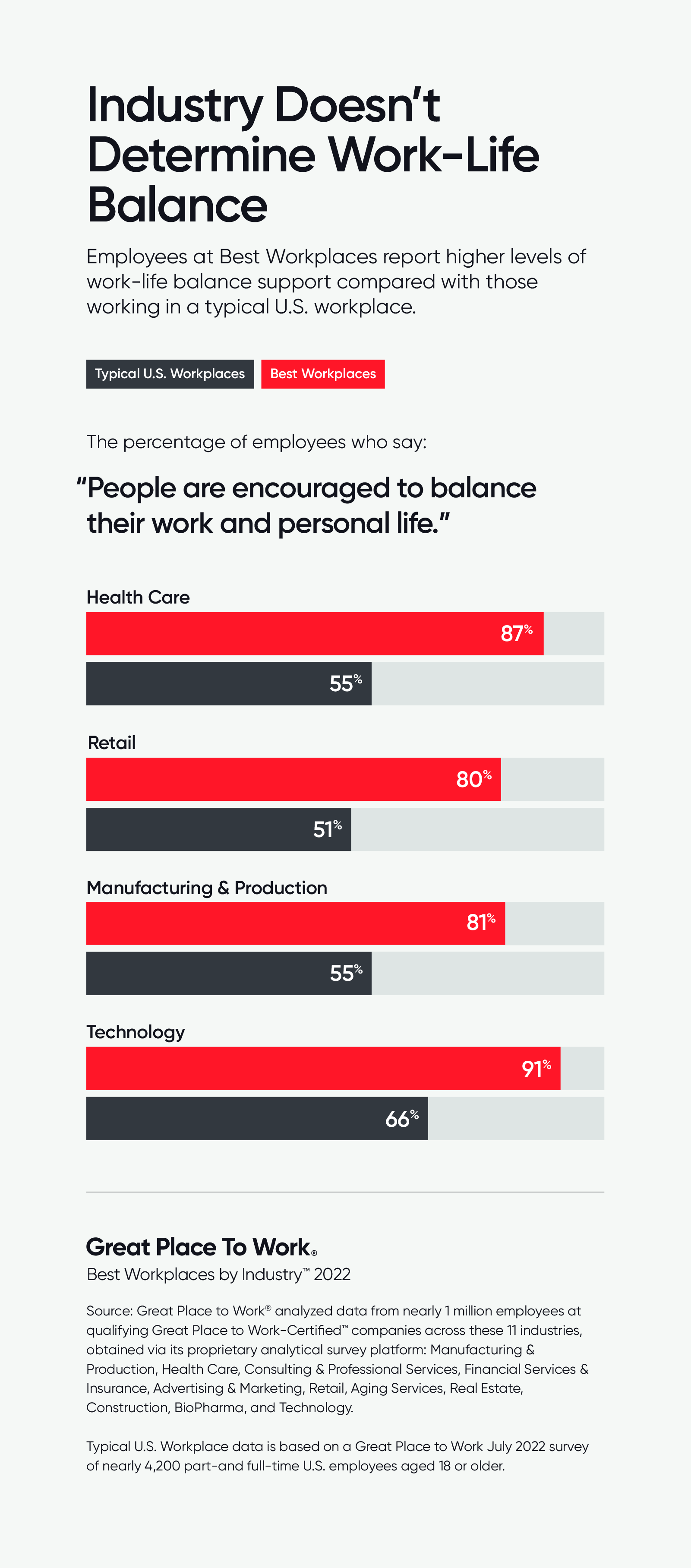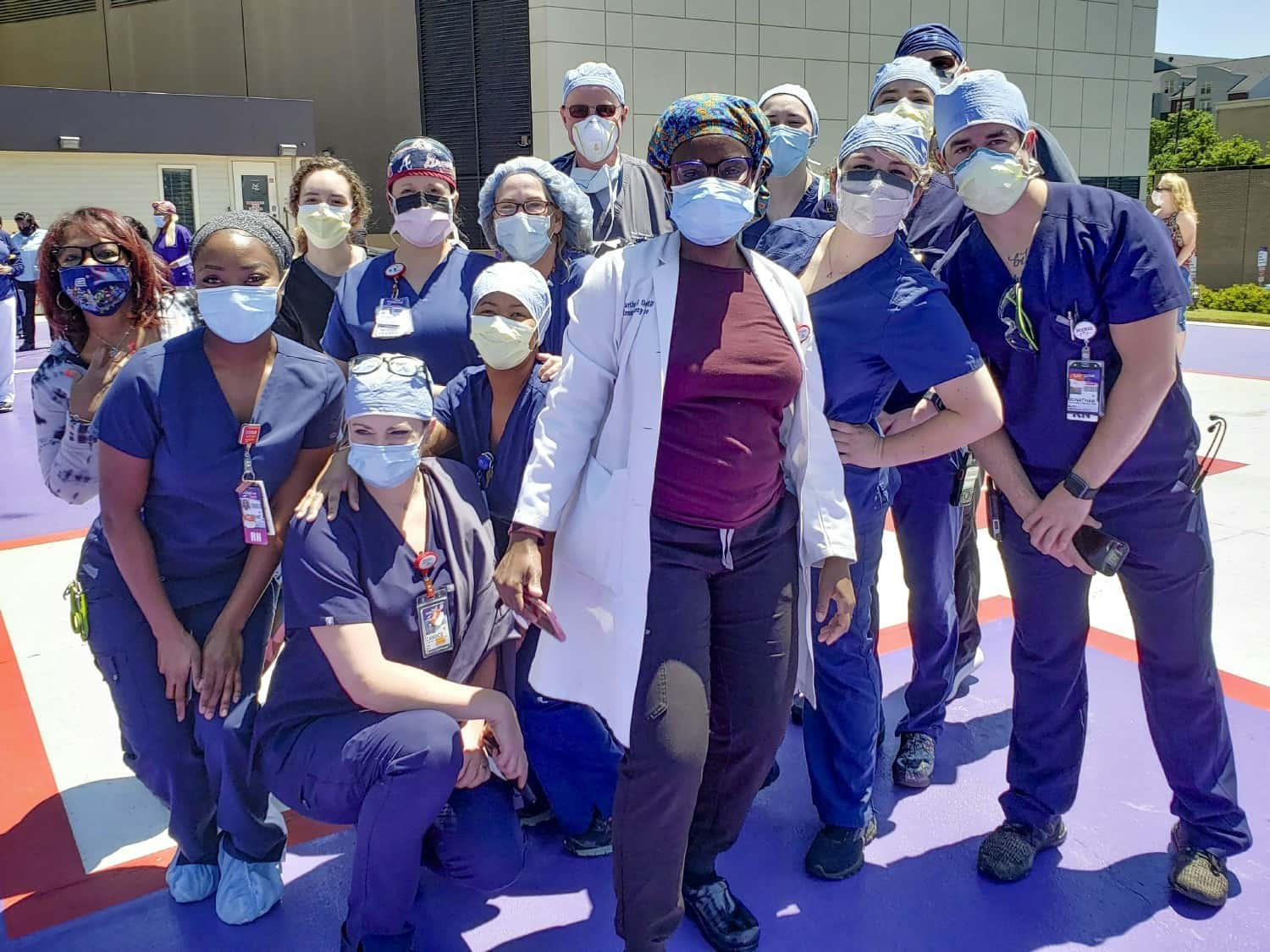Best Workplaces, Employee Well-being
Flexibility, fair pay, and work-life balance are all in reach for companies in health care, an industry plagued with long hours and high stress.
No industry has faced greater challenges from COVID-19 than health care.
Workers on the frontline of a desperate struggle with the pandemic are now pondering their options. Former Surgeon General Vivek Murthy described the situation:
“The toll on our health workers is alarming. Thousands of them have died from Covid. More than half of health workers report symptoms of burnout, and many are contending with insomnia, depression, anxiety, post-traumatic stress disorder, or other mental health challenges.”
Yet, the crisis for health care workers is not unavoidable. Great Place To Work® research shows that companies that create high-trust cultures, offering fair pay and equitable promotions, outperform others in the health care sector.
In a July 2022 market survey of nearly 4,200 part- and full-time employees aged 18 and older, 55% of health care workers reported being encouraged to find a healthy work-life balance.
Only 46% reported a psychologically and emotionally healthy work environment.
Those numbers change when looking at companies that made the Fortune Best Workplaces in Health Care™ List. For these exemplary organizations, 87% of employees on average report being encouraged to find work-life balance. For psychological and emotional safety, the jump is even greater, up 39 points to 85%.
It isn’t obvious how the health care industry can match the flexibility other industries offer.
“We’re struggling with people just leaving the industry as a whole,” says Penny Ferrell, executive director of employee wellness & work-life programs for Wellstar Health System in Atlanta (No. 9 on the Best Workplaces in Health Care List for large organizations).
“Frontline workers don't have the flexibility offered to hybrid or remote workers. They don't have shift work if they go to another industry. How can we make that environment better that they're in everyday so that they don't feel that they have to leave?”

For Texas Health Resources, No. 1 on the Best Workplaces in Health Care List for large organizations, encouraging employees to take time off in between shifts is an important way to limit burnout.
“The bulk of our nurses work three twelves,” says Carla Dawson, chief people officer for Texas Health Resources. “We try to allow for flexibility — encourage employees to take off. We know it’s so important for them to have their breaks.”
Being intentional with scheduling can help ensure workers aren’t overbooked, though that isn’t always an option when the latest COVID surge is filling hospital beds.
For health care organizations like Maven Clinic (No. 1 on the Best Workplaces in Health Care List for small and medium-sized businesses), flexibility is part of the promise behind joining their service.
Maven uses its digital health platform to connect patients with its provider network on issues relating to pregnancy, parenting, pediatrics, fertility, and menopause.
“So much of what Maven offers that the traditional health care system doesn’t is flexibility,” says Julie Binder, SVP of brand and communications at Maven.
“One of the beautiful things about the promise of digital health is that ability for providers to have much more flexibility than the traditional healthcare system.”
That doesn’t mean Maven isn’t working hard to promote balance for employees and providers in its network. One point of emphasis is how leaders model healthy work habits.
“It’s really important that the executive team of Maven model the behavior — taking vacations, spending time with their own family, really modeling what balance looks like — so we’re creating that supportive, empathetic culture wrapped around these benefits,” says Binder.
“As a leadership team, what’s your legacy going to be? Are you going to let that keep happening and just hope that the landscape changes?” - - Penny Ferrell, executive director, employee wellness & work-life programs, Wellstar Health System
Compensation matters
One of the biggest ways that the Best Workplaces in Health Care stand out from their peers is on fair compensation.
At typical health care organizations, only 42% of workers reported fair pay compared to 78% at the Best Workplaces in Health Care.
At Texas Health Resources, the pandemic forced the healthcare system to reassess how it paid employees financial incentives. As a business, the hospital did not meet its key performance indicators for 2020, one of which was a financial trigger. Under its model, it would not have paid incentives to staff, despite their hard work during the onset of COVID-19.
“We made a decision, based on everything that our employees have been through, to pay a ‘promise bonus,’” Dawson says. The sum — a generous amount that was greater than what would have been paid under the incentive plan — was Texas Health Resources’ way of recognizing the extra effort of its people.
“Frontline workers don't have the flexibility offered to hybrid or remote workers. They don't have shift work if they go to another industry. How can we make that environment better that they're in everyday so that they don't feel that they have to leave?” - Penny Ferrell, executive director, employee wellness & work-life programs, Wellstar Health System
The power of pride
In Great Place To Work research, one of the strongest indicators of employee well-being is a sense of pride in one’s work. Employees at the Best Workplaces in Health Care who report pride in their accomplishments are four times as likely to experience well-being.
At Maven Clinic, connecting workers to patient stories is a key way to help them see the real world impact of their efforts.
“We bring in a real patient story every single week to our employee All Hands meeting,” Binder says. The team also has a Care Advocate, a guide and trusted resource to our members, who comes and talks to Maven employees, from software engineers to sales and accounting, about the impact Maven has on patients.
“Hearing that the work that you do enabled that patient experience is hugely motivating,” Binder says.
Business benefits
The data is clear on what happens when health care organizations invest in their people. At the typical health care organization, only 56% of employees plan to stay in their job long-term.
For the Best Workplaces, 89% of employees plan to stick with their employer long-term.
For employers that want to change their culture and improve well-being for employees, what are the options? Ferrell at Wellstar recommends committing to listening, especially when it might be uncomfortable.
Be curious in exit interviews, she says. “If people are leaving, what is causing them to leave? Make sure that you’re finding ways to address those issues, whether it’s ‘I’m working too many hours,’ ‘I don’t like 12-hour shifts,’ or ‘I’ve gained 30 pounds since I joined because of shift work.’”
Ferrell says that leaders have to take responsibility.
“As a leadership team, what’s your legacy going to be? Are you going to let that keep happening and just hope that the landscape changes?”
The best leaders are those that practice what they preach and aren’t afraid of change. You can take baby steps — start with one wellness specialist if you can’t hire a full team yet — but you have to do something.
“Put your money where your mouth is,” says Ferrell. “A lot of people talk the talk — how are you going to make it stick?”
Subscribe
Improve employee retention and engagement with the latest insights from our data and research team. Subscribe to the Great Place To Work newsletter and learn how to create a great workplace culture.











